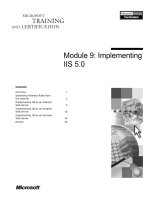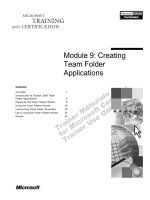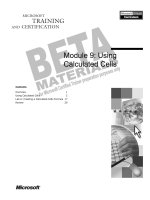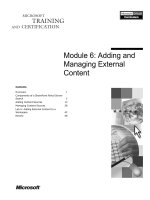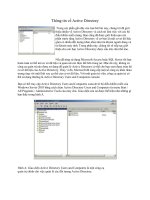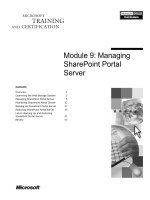Tài liệu Module 9: Resolving Active Directory Replication Conflicts doc
Bạn đang xem bản rút gọn của tài liệu. Xem và tải ngay bản đầy đủ của tài liệu tại đây (993.52 KB, 24 trang )
Contents
Overview 1
Introduction to Active Directory Replication 2
Replication Components and Processes 3
Using Sites to Optimize Active Directory
Replication 13
Identifying Replication Problems by Using
Event Viewer 18
Review 19
Module 9: Resolving
Active Directory
Replication Conflicts
Information in this document, including URL and other Internet Web site references, is subject to
change without notice. Unless otherwise noted, the example companies, organizations, products,
domain names, e-mail addresses, logos, people, places, and events depicted herein are fictitious,
and no association with any real company, organization, product, domain name, e-mail address,
logo, person, places or events is intended or should be inferred. Complying with all applicable
copyright laws is the responsibility of the user. Without limiting the rights under copyright, no
part of this document may be reproduced, stored in or introduced into a retrieval system, or
transmitted in any form or by any means (electronic, mechanical, photocopying, recording, or
otherwise), or for any purpose, without the express written permission of Microsoft Corporation.
Microsoft may have patents, patent applications, trademarks, copyrights, or other intellectual
property rights covering subject matter in this document. Except as expressly provided in any
written license agreement from Microsoft, the furnishing of this document does not give you any
license to these patents, trademarks, copyrights, or other intellectual property.
2001 Microsoft Corporation. All rights reserved.
Microsoft, MS-DOS, Windows, Windows NT, <plus other appropriate product names or titles.
The publications specialist replaces this example list with the list of trademarks provided by the
copy editor. Microsoft, MS-DOS, Windows, and Windows NT are listed first, followed by all
other Microsoft trademarks listed in alphabetical order. > are either registered trademarks or
trademarks of Microsoft Corporation in the U.S.A. and/or other countries.
<The publications specialist inserts mention of specific, contractually obligated to, third-party
trademarks, provided by the copy editor>
The names of actual companies and products mentioned herein may be the trademarks of their
respective owners.
Module 9: Resolving Active Directory Replication Conflicts iii
Instructor Notes
This module provides students with the knowledge and skills to identify Active
Directory
™
directory service replication components and the replication
process. The module also describes how to optimize Active Directory
replication, and identify and resolve potential replication conflicts.
After completing this module, students will be able to:
!
Identify the importance of replication in a Microsoft Windows
®
2000-based
network.
!
Describe the components of replication and the replication process.
!
Describe how sites enable you to optimize Active Directory replication.
!
Identify replication problems by using Event Viewer.
Materials and Preparation
This section provides the materials and preparation tasks that you need to teach
this module.
Required Materials
To teach this module, you need the following materials:
!
Microsoft PowerPoint
®
file 2126A_09.ppt
!
The multimedia file 2126a_09d005.avi, Replication Conflicts
Preparation Tasks
To prepare for this module:
!
Read all of the materials for this module.
!
View the multimedia presentation, Replication Conflicts, under Multimedia
Presentations on the Web page on the Trainer Materials compact disc.
Presentation:
40 Minutes
Lab:
0 Minutes
iv Module 9: Resolving Active Directory Replication Conflicts
Module Strategy
Use the following strategy to present this module:
!
Introduction to Active Directory Replication
Introduce the role of replication in improving the performance of Active
Directory in a Windows 2000-based network. Describe the basic concept of
replication, and explain that replication ensures that all information in
Active Directory is available to all domain controllers and client computers
across the network.
!
Replication Components and Processes
Introduce the components of replication and the replication process. Discuss
the reasons why replication occurs, and the two types of replication updates.
Emphasize the differences between originating and replicated updates.
Present the concept of replication latency during normal and urgent
replication. Emphasize the change notification process. Use the slide in the
Replication Latency topic to describe normal and urgent replication. Next,
discuss why conflicts occur during replication, and how conflicts are
resolved during replication. Describe situations in which a single master
update of a forest is required instead of the usual multi-master update, and
identify the forest-wide and domain-wide roles for domain controllers.
Finally, show the multimedia file, which demonstrates how to resolve
replication conflicts and how to initiate replication without waiting for the
normal replication period.
!
Using Sites to Optimize Active Directory Replication
Introduce how to use sites to optimize Active Directory replication. Discuss
what sites are, and ask students to participate in this discussion to reinforce
their knowledge of sites. Finally, discuss how replication occurs within sites
and between sites.
!
Identifying Replication Problems by Using Event Viewer
Explain how Event Viewer can be used to assist in troubleshooting
replication problems. Describe the different message types and the types of
events that generate them. Finally, identify the different types of event logs.
Refer students to the Microsoft Windows 2000 Server Resource Kit for
more information about event log messages.
Module 9: Resolving Active Directory Replication Conflicts 1
Overview
!
Introduction to Active Directory Replication
!
Replication Components and Processes
!
Using Sites to Optimize Active Directory Replication
!
Identifying Replication Problems by Using Event Viewer
Active Directory
™
directory service replication involves transferring and
maintaining Active Directory data between domain controllers in a network.
Active Directory uses a multi-master replication model. Multi-master means
that there are multiple domain controllers, called masters, which have the
authority to modify or control the same information. So the replication model
must replicate the data changed on one domain controller to another. The multi-
master model must address the fact that changes can be made by more than one
domain controller.
By understanding how Active Directory replication is managed, you can control
replication network traffic and ensure the consistency of Active Directory data
across your network.
After completing this module, you will be able to:
!
Identify the importance of replication in a Microsoft
®
Windows
®
2000-
based network.
!
Describe the components of replication and the replication process.
!
Describe how sites enable you to optimize Active Directory replication.
!
Identify replication problems by using Event Viewer.
Topic Objective
To provide an overview of
the module topics and
objectives.
Lead-in
In this module, you will learn
about managing Active
Directory replication within a
site and between sites.
2 Module 9: Resolving Active Directory Replication Conflicts
Introduction to Active Directory Replication
Replication
Domain
Controller B
Domain
Controller C
Domain
Controller A
Multi-master replication with
a loose convergence
Replication is the process of updating information in Active Directory from one
domain controller to the other domain controllers in a network. Replication
synchronizes the copying of data on each domain controller. Synchronization
ensures that all information in Active Directory is available to all domain
controllers and client computers across the entire network.
When a user or administrator performs an action that initiates an update to
Active Directory, an appropriate domain controller is automatically chosen to
perform the update. This change is made transparently at one of the domain
controllers.
Active Directory provides multi-master replication with loose convergence. In
Active Directory, multi-master replication provides two advantages:
!
With few exceptions, there is no single domain controller that, if
unavailable, must be replaced before updates to Active Directory can
resume.
!
The presence of more than one domain controller provides a level of fault
tolerance against certain problems, such as a hard disk failure. In addition,
domain controllers can be distributed across the network and located in
multiple physical sites. Locating domain controllers at multiple physical
sites provides a further level of fault tolerance for disaster recovery
purposes.
Active Directory uses sites to identify well-connected computers in an
organization to optimize network bandwidth. Replication within sites occurs
between domain controllers in the same site and is designed to work with fast,
reliable connections. Replication between sites occurs between the domain
controllers located on different sites and is designed under the assumption that
the network links between sites have limited bandwidth and availability.
Slide Objective
To illustrate the importance
of replication in a
Windows 2000 network.
Lead-in
Replication ensures that all
information in Active
Directory is available to all
domain controllers and
client computers across the
entire network.
Delivery Tip
Introduce the basic concept
of replication without using
any technical terms. Tell the
students that replication can
occur within or between
sites. Do not go into the
details of how replication
occurs in these two
situations.
Module 9: Resolving Active Directory Replication Conflicts 3
"
""
"
Replication Components and Processes
!
How Replication Works
!
Replication Latency
!
Resolving Replication Conflicts
!
Single Master Operations
Replication of updates is initiated when one or more objects on a domain
controller are added, modified, deleted, or moved. When one of these updates
occurs, the replication process occurs between domain controllers through the
interaction of components of replication.
Replication in Active Directory propagates changes and tracks the changes
among domain controllers. Each domain controller in a forest stores a copy of
specific parts of the Active Directory structure. Although replication has the
effect of synchronizing information in Active Directory for an entire forest of
domain controllers, the actual process of replication occurs between only two
domain controllers at a time.
Because the domain controllers are both masters for the data, and each has its
own updatable copy, delay in replication across domain controllers may
sometimes result in replication conflicts between domain controllers. Active
Directory automatically resolves these conflicts.
Topic Objective
To introduce the topics that
are related to replication
components and processes.
Lead-in
In addition to physical
structure, several
components influence
replication.
4 Module 9: Resolving Active Directory Replication Conflicts
How Replication Works
Replication
Originating Update
Originating Update
Domain
Controller A
Domain
Controller B
Domain
Controller C
Replicated Update
Replicated Update
Replicated Update
Replicated Update
Active Directory Update
!
Move
!
Delete
!
Add
!
Modify
Replication of information in all domain controllers occurs because Active
Directory has been updated. Active Directory can be updated in one of the
following ways:
!
Adding an object to Active Directory, such as creating a new user account.
!
Modifying an object’s attribute values, such as changing the phone number
for an existing user account.
!
Modifying the name or parent of an object, and if necessary, moving the
object into the new parent’s domain. For example, you move the object
from the sales domain to the service domain.
!
Deleting an object from the directory, such as deleting the user accounts of
employees who no longer work for the organization.
Each update to Active Directory generates a request that can either commit or
not commit to the database. A committed request is an originating update. After
an originating update, the data must be replicated to all other replicas
throughout the network.
An update performed at a domain controller that did not originate the update is
called a replicated update. A replicated update is a committed update
performed on one replica as a result of an originating or replicated update
performed at another replica.
For example, an originating update occurs when users change their passwords
at Domain Controller A, and Domain Controller A writes the password to the
directory. When Domain Controller A replicates the change to Domain
Controller B, and Domain Controller B updates its own copy of the directory,
there is a replicated update at Domain Controller B.
Slide Objective
To identify the reasons why
replication occurs, and
describe the two types of
replication updates.
Lead-in
Update requests to Active
Directory are either
originating updates or
replicated updates.
Key Points
A committed request as a
result of a change in the
Active Directory database is
an originating update.
An update performed at a
domain controller that did
not originate the update is a
replicated update.
Module 9: Resolving Active Directory Replication Conflicts 5
Replication Latency
Replication
Domain
Controller A
Change Notification
Change Notification
Domain Controller C
Domain
Controller B
Replicated Update
Replicated Update
Replicated Update
Replicated Update
!
Default replication latency (change notification) = 5 minutes
!
When no changes, scheduled replication = one hour
!
Urgent replication = immediate change notification
Originating Update
Originating Update
Replication latency is the time that is required for a change made on one
domain controller to be received by another domain controller. When an update
is applied to a given replica, the replication engine is triggered.
Change Notification
Replication within a site occurs through a change notification process. When an
update occurs on a domain controller, the replication engine waits for a
configurable interval, which is five minutes by default, and then sends a
notification message to the first replication partner, informing it of the change.
Each additional direct partner is notified after a configurable delay, which is 30
seconds by default.
As a result,, the maximum propagation delay for a single change, assuming the
default configuration and the three-hop limit (hops means moving data from
one domain controller to another domain controller), should be 15 minutes,
which may include the 30-second configurable delay. When the replication
partners receive the change notification, they copy the changes from the
originating domain controller.
If no changes occur during a configurable period, which is one hour by default,
a domain controller initiates replication with its replication partners to ensure
that no changes from the originating domain controller were missed.
Slide Objective
To illustrate the concept of
replication latency during
normal and urgent
replication.
Lead-in
When an update is applied
to a given replica, it takes
some time before the
change made on one
domain controller is
received by another domain
controller.
Key Points
The default replication
latency period is five
minutes.
The maximum propagation
delay for a single change,
assuming the default
configuration and the three-
hop limit, is 15 minutes.
Urgent replication sends
change notification
immediately in response to
urgent events, instead of
waiting the default period of
five minutes.
6 Module 9: Resolving Active Directory Replication Conflicts
Urgent Replication
Attribute changes in Active Directory that are considered security-sensitive are
immediately replicated by partners that are immediately notified. This
immediate notification is called urgent replication.
Urgent replication sends notification immediately in response to urgent events
instead of waiting the default period of five minutes. For example, urgent
replication between domain controllers is prompted when an administrator
assigns an account lockout. Account lockout is a security feature that sets a limit
on the number of failed authentication attempts that are allowed before the
account is denied any further attempts to log on, and a time limit for how long
the lockout is in effect.
Events That Trigger Urgent Replication
Urgent replication between Windows 2000–based domain controllers within the
same site is prompted by the following events:
!
Assignment of an account lockout, which prohibits a user from logging on
after a certain number of failed attempts.
!
Change in a Local Security Authority (LSA) secret, which is a secure form
in which private data is stored by the LSA. LSA is a protected subsystem
that authenticates and logs users onto the local system. LSA maintains
information about all aspects of local security on a system (collectively
known as the local security policy), and provides various services for
translation between names and identifiers. LSA secrets are objects that are
provided by the LSA to enable system services to store private data
securely.
!
Change in the relative identifier (RID) master role owner, which is the
single domain controller in a domain that assigns relative identifiers to all
domain controllers in that domain. A relative identifier is the part of a
security ID (SID) that uniquely identifies an account or group in a domain.
Module 9: Resolving Active Directory Replication Conflicts 7
Resolving Replication Conflicts
Domain Controller A
Originating Update
Originating Update
Domain Controller B
Conflict
Conflict
Originating Update
Originating Update
Stamp
Stamp
Stamp
Stamp
Conflict
Conflict
Version Number
Timestamp
Timestamp
Server GUID
Stamp
Stamp
Conflicts may arise because of:
!
Attribute value
!
Adding/moving under a deleted container object or the deletion of
a container object
!
Sibling name
Because replication in Active Directory is based on a multi-master model, all
computers that provide multi-master updates must handle potential conflicts
that may arise when concurrent updates that originate on two separate master
replicas are inconsistent. When the updates are replicated, these concurrent
updates cause a conflict. Active Directory both minimizes and resolves
conflicts.
Types of Conflicts
There are three conflict types:
!
Attribute value. This conflict occurs when an object’s attribute is set
concurrently to one value at one replica and to another value at a second
replica.
!
Add or move under a deleted container object or the deletion of a container
object. This conflict occurs when one replica records the deletion of a
container object, while another replica records the placement of any object
that is subordinate to the deleted container object.
!
Sibling name. This conflict occurs when one replica attempts to move an
object into a container in which another replica has concurrently moved
another object with the same relative distinguished name.
Minimizing Conflicts
To help minimize conflicts, domain controllers record and replicate changes to
objects at the attribute level, rather than the object level. Therefore, changes to
two different attributes of an object, such as the user’s password and postal
code, do not cause a conflict even if they are changed at the same time.
Slide Objective
To identify why conflicts
occur during replication, and
how conflicts are resolved
during replication.
Lead-in
Replication conflicts arise
when concurrent updates
originating on two separate
master replicas are
inconsistent.
Delivery Tip
Active Directory replication
does not depend on time to
determine which changes
must be propagated.
Instead, it relies on the use
of upgrade sequence
numbers (USN) that are
assigned by a counter that
is local to each domain
controller. Because these
USN counters are local, it is
easy to ensure that they are
reliable and never decrease
in value. However, you
cannot compare a USN that
is assigned on one domain
controller to a USN that is
assigned on another domain
controller. The replication
system is designed with this
restriction in mind.
8 Module 9: Resolving Active Directory Replication Conflicts
Globally Unique Stamps
To aid in conflict resolution, Active Directory maintains a stamp that contains
the version number, timestamp, and server globally unique identifier (GUID)
that are created during an originating update. This stamp travels with the update
as it replicates.
The stamp has the following three components in order from most to least
significant:
!
Version Number. The version number starts at one and increases by one for
each originating update. When performing an originating update, the version
of the updated attribute is one number higher than the version of the
attribute that is being overwritten.
!
Timestamp. The timestamp is the originating time and date of the update
according to the system clock of the domain controller that performed the
originating update.
!
Server GUID. The server GUID is the originating Directory System Agent
(DSA) that identifies the domain controller that performed the originating
update.
Resolving Conflicts
Conflicts are resolved by assigning a globally unique stamp to all originating
update operations, such as add, modify, move, or delete. If there is a conflict,
the ordering of stamps allows a consistent resolution in the following ways:
!
Attribute value. The update operation that has the higher stamp value
replaces the attribute value of the update operation with the lower stamp
value.
!
Add or move under a deleted container object or the deletion of a container
object. After resolution occurs at all replicas, the container object is deleted,
and the leaf object is made a child of the folder’s special LostAndFound
container. Stamps are not involved in this resolution.
!
Sibling name. The object with the larger stamp retains the relative
distinguished name. The sibling object is assigned a unique relative
distinguished name by the domain controller. The name assignment is the
relative distinguished name + “CNF:” + a reserved character (*) + the
object’s GUID. This name assignment ensures that the generated name does
not conflict with the name of any other object.
Module 9: Resolving Active Directory Replication Conflicts 9
Single Master Operations
!
Only a domain controller that holds a specific operations master role
can perform associated Active Directory changes
!
Changes made by an operations master are replicated to other
domain controllers
!
Any domain controller can hold an operations master role
!
Operations master roles can be moved to other domain controllers
Single Master
Operations
Operations
Master
Replication
Active Directory supports multi-master replication of directory changes among
all domain controllers in a forest. During multi-master replication, a replication
conflict can occur if concurrent originating updates are performed on the same
data on two different domain controllers.
To avoid these conflicts, some single master (not permitted to occur at different
places in the network at the same time) operations are performed by making a
single domain controller responsible for the operation.
These operations are grouped together into specific roles within the forest or
within a domain. These roles are called operations master roles. For each
operations master role, only the domain controller holding that role can make
the associated directory changes. The domain controller responsible for a
particular role is called an operations master for that role.
Active Directory stores information about which domain controller holds a
specific role. Clients that can query Active Directory use this information to
contact an operations master when necessary. Any domain controller can
potentially be configured as an operations master. It is possible to move an
operations master role to other domain controllers, even when the current
operations master role holder is unavailable.
Slide Objective
To introduce the use of an
operations master in Active
Directory.
Lead-in
There are situations in
which a single master
update of a forest is
required, instead of the
usual multi-master update.
Key Points
Operations masters perform
updates to the forest that
should not be performed as
multi-master updates.
Any domain controller can
be an operations master.
You can move an
operations master role to
other domain controllers.
10 Module 9: Resolving Active Directory Replication Conflicts
Forest-Wide Roles
Every Active Directory forest must have domain controllers that fulfill two of
the five single master operations roles (both roles can be fulfilled by the same
domain controller). The forest-wide roles are:
!
Schema master. The domain controller that is assigned to control all updates
to the schema within a forest. The schema master domain controller controls
all updates and modifications that relate to the information in Active
Directory.
There can be only one schema master in the forest.
!
Domain naming master. The domain controller that is assigned to control
the addition or removal of domains in the forest.
There can be only one domain naming master in the forest.
Domain-Wide Roles
Every Active Directory domain must have domain controllers that fulfill three
of the five single master operations roles (any or all of the three roles can be
fulfilled by the same domain controller, which may also be fulfilling one or
both of the forest-wide roles). The domain-wide roles are:
!
Relative identifier (RID) master. The domain controller that is assigned to
allocate sequences of relative IDs to each domain controller in its domain.
Whenever a domain controller creates a user, group, or computer object, it
assigns the object a unique security identifier (SID). The SID consists of a
domain SID that is the same for all SIDs that are created in the domain, and
a RID that is unique for each SID that is created in the domain.
There can be only one RID master in a domain.
!
Primary domain controller (PDC) emulator. The domain controller that is
assigned to function as a Microsoft Windows NT
®
4 primary domain
controller (PDC) to service network clients that do not have Active
Directory client software installed.
If the domain contains computers that are not running Windows 2000 client
software, such as Windows 95 and Windows 98 clients, the PDC emulator
functions as a Windows NT 4 primary domain controller and handles
password changes made at those clients.
In a Windows 2000 domain, the PDC emulator receives preferential
replication of password changes that are performed by other domain
controllers in the domain. If a password was recently changed, that change
takes time to replicate to every domain controller in the domain. If a logon
authentication fails at another domain controller because of a bad password,
that domain controller will forward the authentication request to the PDC
emulator before it rejects the logon request.
There can be only one PDC emulator in a domain.
Note
Note
Note
Note
Module 9: Resolving Active Directory Replication Conflicts 11
!
Infrastructure master. The domain controller that is assigned to update
group-to-user references whenever group memberships are changed, and to
replicate these changes to any other domain controllers in the domain.
If modifications to user accounts and group memberships are made in
different domains, there is a delay between the time that you rename a user
account and the time when a group that contains that user will display the
new name of the user account. The infrastructure master of the group’s
domain is responsible for this update; it distributes the update through multi-
master replication.
There can be only one infrastructure master in a domain.
Note
12 Module 9: Resolving Active Directory Replication Conflicts
Multimedia: Replication Conflicts
The presentation discusses how to resolve the three possible conflict types:
!
Attribute value. This conflict occurs when an object’s attribute is set
concurrently with another object’s attribute.
!
Add/move under a deleted container object. This conflict occurs when you
add or move objects under a deleted container object.
!
Sibling name. This conflict occurs when you attempt to move an object into
a container in which another object with the same relative display name has
already been moved.
In addition, you will learn how to initiate replication without having to wait for
the normal replication period.
Topic Objective
To demonstrate the
procedures for resolving
replication conflicts.
Lead-in
In this presentation, you will
learn how to resolve
replication conflicts.
Delivery Tip
To view this demonstration,
open the Web page on the
Student Materials compact
disc, click Multimedia
Presentations, and then
click Replication Conflicts.
Inform students that a copy
of the multimedia
presentation is included on
the Web page on the
Student Materials compact
disc.
Module 9: Resolving Active Directory Replication Conflicts 13
"
""
"
Using Sites to Optimize Active Directory Replication
!
What Are Sites?
!
Replication Within Sites
!
Replication Between Sites
Replication ensures that all information in Active Directory is current on all
domain controllers across your entire network. Many networks consist of a
number of smaller networks, and the network links between these networks
may operate at varying speeds.
Sites in Active Directory enable you to control replication traffic and other
types of traffic that are related to Active Directory across these various network
links.
Topic Objective
To introduce the topics that
are related to using sites to
optimize Active Directory
replication.
Lead-in
Sites enable you to control
replication traffic and other
types of traffic that are
related to Active Directory
across various network
links.
14 Module 9: Resolving Active Directory Replication Conflicts
What Are Sites?
!
The first site is set up automatically, and is called Default-First-Site-
Name
!
Sites can consist of zero, one, or more subnets
!
Sites are used to control replication traffic and logon traffic
!
Sites contain server objects and are associated with IP subnet
objects
AD Sites and Services
C
onsole Window Help
A
ctive View
Tree
Active Directory Sites and Services
Sites
Default-First-Site-Name
Servers
Inter-Site Transports
Subnets
Site
Inter-Site Transport Container
Site
Subnets Container
Name Type
Redmond-Site
Default-First-Site-Name
Inter-Site Transports
Redmond-Site
Subnets
DENVER
NTDS Settings
Sites help define the physical structure of a network. A site is defined by a set
of Transmission Control Protocol/Internet Protocol (TCP/IP) subnet address
ranges. The first site is set up automatically when you install Active Directory
on the first domain controller in a forest. The resulting first site is called
Default-First-Site-Name. This site can be renamed.
A site can consist of no subnets or one or more subnets. For example, in a
network with three subnets in Redmond and two in Paris, the administrator can
create a site in Redmond and a site in Paris, and then add the subnets to the
respective sites.
A site may contain domain controllers from any domain in the forest. Sites
consist of server objects. The server objects are created for a computer when it
is promoted to a domain controller, and contain connection objects that enable
replication.
You can use sites to control:
!
Replication traffic. When a change occurs in Active Directory, sites can be
used to control how and when the change is replicated to domain controllers
in another site.
!
Logon traffic. When a user logs on, Windows 2000 attempts to find a
domain controller in the same site as the workstation.
!
Application traffic. Applications, such as Distributed File System (DFS),
can also take advantage of the site topology information to optimize
network traffic.
Slide Objective
To identify the purpose of
sites in Active Directory.
Lead-in
Sites help define the
physical structure of a
network. The first site is set
up automatically when you
install Windows 2000
Advanced Server on the first
domain controller in a forest.
Key Point
Sites can control traffic,
such as replication traffic,
workstation logon traffic,
and application traffic.
Module 9: Resolving Active Directory Replication Conflicts 15
Replication Within Sites
Replication within sites:
!
Occurs between domain controllers in the same site
!
Assumes fast and highly reliable network links
!
Does not compress replication traffic
!
Uses a change notification mechanism
IP Subnet
IP Subnet
Domain
Controller A
Domain
Controller B
IP Subnet
IP Subnet
Site
Replication
Replication
Replication within sites occurs between domain controllers in the same site.
Because a site assumes fast, highly reliable network links, replication traffic
within a site is uncompressed. Uncompressed replication traffic helps reduce
the processing load on the domain controllers. However, this uncompressed
traffic can increase the network bandwidth that is required for replication
messages. The network connection is assumed to be both reliable and have
available bandwidth. Replication by default occurs within a site through a
change notification process.
Slide Objective
To illustrate how replication
occurs within sites.
Lead-in
Replication within a site is
designed to work with fast,
reliable connections.
16 Module 9: Resolving Active Directory Replication Conflicts
Replication Between Sites
Replication between sites:
!
Occurs on a manually
defined schedule
!
Is designed to optimize
bandwidth
!
One or more replicas in
each site act as
bridgeheads
Site
IP Subnet
IP Subnet
IP Subnet
IP Subnet
Bridgehead
Server
Replication
Replication
Site
IP Subnet
IP Subnet
IP Subnet
IP Subnet
Bridgehead
Server
Replication
Replication
Replication
Replication
Replication between sites is designed under the assumption that the network
links between sites have limited available bandwidth and may not be reliable.
Replication Scheduling
Replication between sites happens automatically after you define configurable
values, such as a schedule and a replication interval. You can schedule
replication for inexpensive or off-peak hours. By default, changes are replicated
between sites according to a manually defined schedule and not according to
when changes occur.
Configurable values, such as a schedule or an interval, define when and how
often replication occurs between sites. The schedule determines at which times
replication is allowed to occur, and the interval specifies how often domain
controllers check for changes during the time that replication is allowed to
occur.
Compressed Traffic
Replication traffic between sites is designed to optimize bandwidth by
compressing all replication traffic between sites. Replication traffic is
compressed to 10 to 15 percent of its original size before it is transmitted.
Although compression optimizes network bandwidth, it imposes an additional
processing load on domain controllers.
Slide Objective
To illustrate how replication
occurs between sites.
Lead-in
Replication between sites is
designed under the
assumption that the network
links between sites have
limited available bandwidth
and may not be reliable.
Module 9: Resolving Active Directory Replication Conflicts 17
Bridgehead Servers
When replication occurs between sites, one or more replicas in each site act as
bridgeheads to another site in the topology. Bridgehead servers are the contact
point for exchange of directory information between sites.
A server is automatically designated as a bridgehead server by using the
Intersite Topology Generator (ISTG) in each site to perform replication
between sites. After replication between sites is completed by using the
bridgehead server, the bridgehead servers communicate all updates to all
domain controllers within their sites by using the normal replication process.
18 Module 9: Resolving Active Directory Replication Conflicts
Identifying Replication Problems by Using Event Viewer
If replication problems occur, Windows 2000 generates messages that you can
view by using Event Viewer. The following types of messages can be viewed:
!
Informational. These messages typically report the status of tasks
performed. For example, an informational message reports that replication
has completed successfully.
!
Warning. These messages provide warnings, which indicate that action may
be required. For example, if one domain controller makes an unsuccessful
attempt to contact another domain controller, Event Viewer generates a
warning message.
!
Error. These messages provide notification of a significant problem. For
example, if replication fails, Event Viewer generates an error message.
On a domain controller, there may be up to six different event logs:
Application, Directory Service, Domain Name System (DNS) server, File
Replication Service, Security, and System.
The Directory Service log and System log contain information that can help you
troubleshoot replication problems. The DNS server log can also help you
troubleshoot replication problems because Active Directory uses DNS
extensively, and a DNS problem may cause replication to fail.
For more information about event log messages, see the Distributed
Systems Guide in the Windows 2000 Server Resource Kit.
Topic Objective
To describe how Event
Viewer can be used to
identify replication problems.
Lead-in
Active Directory replication
generates messages, which
you can view by using Event
Viewer. These messages
can assist you in
troubleshooting replication
problems.
Note
Module 9: Resolving Active Directory Replication Conflicts 19
Review
!
Introduction to Active Directory Replication
!
Replication Components and Processes
!
Using Sites to Optimize Active Directory Replication
!
Identifying Replication Problems by Using Event Viewer
1. Why is replication important?
Replication ensures that all information in Active Directory is available
to all domain controllers and client computers across the entire
network.
2. An administrator changes the telephone number on a user object in Active
Directory on one domain controller. A short time later, the user changes his
pager number on another domain controller. What happens to the two
changes when they are replicated to domain controllers throughout the
domain?
Both attribute changes are replicated to all domain controllers. Because
different attributes were updated, and replication is maintained at the
attribute level, no conflict occurs.
3. You want to limit the replication traffic between two domain controllers that
are connected by a wide area network (WAN) link. You also want this link
to be used only for replication traffic at night. What should you do?
Put the domain controllers in separate sites, and create a site link
between them with a replication that is scheduled to occur only at night.
4. To reduce congestion on your network, the Network Services group in your
organization has created a new high-speed backbone on a separate IP subnet
for servers in your location. What should you do before you move your
domain controllers to the new backbone?
Associate the backbone’s subnet with a site.
Topic Objective
To reinforce module
objectives by reviewing key
points.
Lead-in
The review questions cover
some of the key concepts
taught in the module.
THIS PAGE INTENTIONALLY LEFT BLANK

